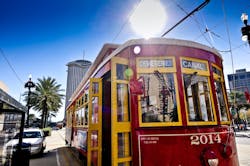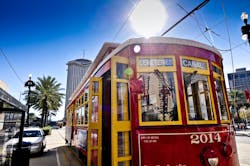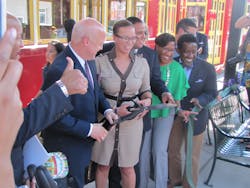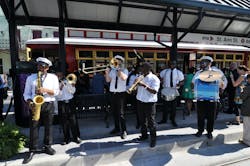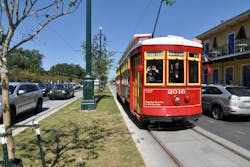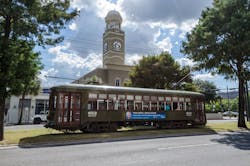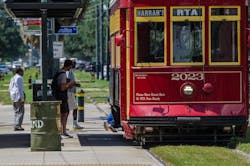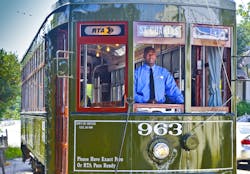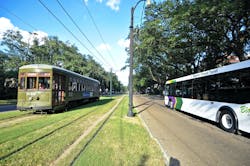RAIL WEB EXCLUSIVE: Keeping with the beat
Streetcars have been an integral part of the New Orleans public transportation network since the first half of the 19th century. The longest of New Orleans’ streetcar lines is the St. Charles Avenue line. This streetcar line is the oldest continuously operating street railway system in the world, in operation since 1835. It was electrified in 1893 and is now a National Historic Landmark. Today, there are five operating streetcar lines throughout the city: the aforementioned St. Charles Avenue Line, the Riverfront Line, the Canal/City Park Line, the Canal/Cemeteries Line and the Loyola Avenue Line. The New Orleans Regional Transit Authority (NORTA) opened its sixth streetcar line with the Rampart/St. Claude Line entering revenue service in October 2016.
In the mid-19th to early 20th century, New Orleans had dozens of streetcar lines operating. Some of those historic lines included the Jackson Avenue, Louisiana Avenue, Napoleon Avenue, Esplanade Avenue and Magazine Street lines.
By the 1930s and 1940s a growing shift towards automobiles had begun to usurp the community’s reliance on streetcars. This was coupled with a shift in demographics and housing patterns away from the city, as many families moved to the suburbs. By 1953, only the St. Charles Avenue and the Canal Street lines remained in service. And by 1964, the Canal St. line was replaced by bus service. Of all the lines that operated in the city of New Orleans, the St. Charles Avenue Line is the only one that survived this shift—a shift that reflected what was, at the time, a nationwide rush toward single-driver vehicles. Preservationists were unable to save the streetcars on Canal Street, but were able to protect the St. Charles Avenue Line by securing its historic landmark status. All other lines were replaced by bus service in the time period from the late 1940s to the early 1960s.
The Canal Line connects with almost every bus route currently in service around the city and serves as a connector to employment, healthcare, education and entertainment for community residents.
A sign of change
In the later part of the 20th century, national trends began to favor light-rail transit systems again.
The City of New Orleans and NORTA were poised to lead a nationwide charge to return light-rail systems to operation. Based on the success of the St. Charles Avenue streetcar line, NORTA leaders knew that rail systems could easily integrate into existing transit systems as a part of their multimodal service models. With that knowledge and a desire to provide transit in the dense French Quarter community, the agency built the Riverfront Streetcar Line in the mid 1980s and opened that line on Oct. 14, 1988. This was the first new streetcar route in New Orleans in 62 years. The Riverfront Line runs parallel to the river from Esplanade Avenue along the edge of the French Quarter. It is nestled between the French Market and the Mississippi River, and enjoys high ridership by locals and tourists enjoying the sights and sounds accessible along this route.
With the successful build out of the Riverfront streetcar line, NORTA immediately began to seek funding opportunities to restore additional streetcar lines along major corridors where seamless integration to the bus network could be planned. NORTA was determined to continue the renaissance of the light-rail system in the city following this successful project and began to work toward restoring one of the most iconic of streetcar routes—the Canal Street Line.
Service eventually returned to Canal Street in 2004, 40 years after it had been shut down, with two routes to popular and well-traveled destinations. The Canal Streetcar line, which originally operated from 1861 to 1964, runs the entire length of Canal Street, from near the Mississippi River to the cemeteries at City Park Avenue. A branch line turns off of Canal Street onto North Carrollton Avenue to the entrance of City Park at Esplanade Avenue, near the New Orleans Museum of Art. The Canal Street Line’s two routes are named appropriately the ‘Canal to Cemeteries’ patterned after the original ‘Cemeteries’ line, and the ‘Canal to City Park and Museum’, a new destination into the heart of the city. The entirety of the Canal Line and its two routes connects with almost every bus route currently in service citywide, and serves as a major connector to employment, healthcare, education and entertainment for residents of the community. The ‘Canal to Cemeteries’ route of the Canal Line is scheduled for an extension onto Canal Boulevard in 2017, where it will terminate at a newly constructed multimodal terminal connecting it to bus lines from Orleans Parish and to the buses from neighboring Jefferson Parish.
Work on the Rampart/St. Claude Line broke ground in January 2015 and entered revenue service in October 2016.
Pressing forward
In January 2013, NORTA opened the Union Passenger Terminal/Loyola Avenue Streetcar line. The route of this line connects riders from the Union Passenger Terminal to Canal Street and then continues down Canal Street to its terminus at the river. The Union Passenger Terminal/Loyola Avenue Streetcar line consists of 1.6 track miles, is fully ADA accessible and was funded by a $45 million Transit Investment Generating Economic Recovery (TIGER) grant. The build-out of this streetcar line was not without challenges, primary of which was complicated underground utility work due to the line’s trajectory adjacent to a 100-year-old waterline network that served as the main water supply for the city’s central business district. During construction, 133 differing site conditions were discovered including tree stumps, unknown utilities, abandoned tanks and wells, and old structures and foundations. Additionally, this project took place in the bustling central business district corridor in front of a railroad terminal, as well as the city’s sports arenas, City Hall and major hotels and theaters. This mandated that complicated phasing and traffic control be put in place throughout the construction timeline, in order to mitigate congestion and accommodate the city’s historic position as a pedestrian-friendly city. Upon the successful completion of this project, the new route was credited with stimulating $2.7 billion in new infrastructure, retail and commercial developments along the streetcar corridor.
In 2016, NORTA was in the final phase of construction of its latest streetcar route. Work on the Rampart/St. Claude Line broke ground in January 2015 and, as mentioned, entered revenue service in October 2016.
This $67 million streetcar expansion project consisted of 3.2 track miles and included the addition of a new traction power sub station to power the route, as well as future routes being considered for additional expansion of the rail network. The Rampart/St. Claude Line travels from Canal Street down N. Rampart and St. Claude Avenue to Elysian Fields Avenue, with six sheltered stops along the length of the route. It is a key artery for the local population workforce and transit-dependent residents along the corridor, offering direct access to employment opportunities in the central business district and connectivity to other neighborhoods across the city.
A working philosophy
The philosophy that streetcar lines provide efficient transit services which benefit residents and businesses throughout the neighborhoods they pass through, and serve as an economic engine for revitalization of those communities, is one that is steadily, if slowly, gaining ground in the U.S. Recent developments in Texas and California exemplify this fact. The impact of transit on communities is far greater than just moving riders from one destination to another. More important than mere modality, transit spurs economic development. This has been proven nationally, and is certainly true in the New Orleans market. Property values have increased as investments in rail lines have occurred in this city dating as far back as 1835’s the launch of the historic St. Charles Avenue Line. This positive economic impact continues today as demonstrated by the Loyola Avenue Line’s impact on the corridor and the value of the private investment that was precipitated by its build-out.
For NORTA, planning for the future of transportation in New Orleans is a top priority. To accomplish this goal, the agency has initiated a process to chart the future of transit in the coming months. An inclusive strategic planning process will go into effect throughout 2017 and into 2018. This process will consider all modes of transportation, including light rail. NORTA’s strategic planning process will give citizens a voice in designing a transit plan that will meet the needs of generations to come. The process will assess the current multimodal network of buses, streetcars, ferry operations and paratransit; determine whether new modes of transit are needed; and review aspects of service delivery models, all in effort to make ridership successful, easy for the community and targeted to the needs of the citizens—as voiced by those citizens.
The New Orleans Regional Transit Authority currently operates six streetcar lines in the city.
In addition, this process will assess the physical and financial resources at hand and identify new funding streams for future expansions. NORTA will collaborate with the city of New Orleans’ Master Plan process, study mobility patterns, job growth, housing patterns, and future retail, university, school, and medical center growth to intelligently develop a roadmap that will chart the future of transit in five-, 10-, and 20-year horizons. This official strategic planning process will follow federally mandated guidelines for long-term transit planning and public involvement.
If it is the role of a large urban area to find the precise syncopation of serving its community and serving as an example to other communities, New Orleans has decided to place its finger on the pulse and ride along to the beat.
